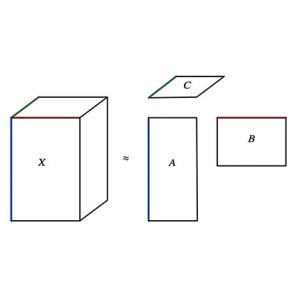 In 1959, Richard Feynman challenged the electron microscopy community to build a better microscope that could identify all the atoms in a chemical structure. As Feynman’s challenge has now been addressed in several systems, a bigger challenge going beyond Feynman’s 1959 vision is to develop multi-dimensional (D) electron microscopy (with D >3) to locate and identify all atomic species in complex systems, with additional dimensions such as time, energy, temperature and external bias. Such a powerful tool would have transformative impact in physics, chemistry, materials science, nanoscience and other fields. Addressing this major challenge requires the advancement and integration of state-of-the-art electron microscopy methods such as atomic electron tomography, ptychography, 4D scanning transmission electron microscopy and spectroscopic techniques as well as powerful computational algorithms and mathematical modeling. The goal of this workshop is to connect mathematicians with experts in imaging, physics, materials science, and computer science to advance modeling, simulation and analysis by incorporating state-of-the-art mathematical and computational tools and methods into multi-dimensional electron microscopy. It will be instrumental to build foundations for interdisciplinary research by engaging all these research areas. This workshop will provide the opportunity to present and exchange ideas, share data, and introduce new tools and develop new imaging paradigms needed in a variety of fields.
In 1959, Richard Feynman challenged the electron microscopy community to build a better microscope that could identify all the atoms in a chemical structure. As Feynman’s challenge has now been addressed in several systems, a bigger challenge going beyond Feynman’s 1959 vision is to develop multi-dimensional (D) electron microscopy (with D >3) to locate and identify all atomic species in complex systems, with additional dimensions such as time, energy, temperature and external bias. Such a powerful tool would have transformative impact in physics, chemistry, materials science, nanoscience and other fields. Addressing this major challenge requires the advancement and integration of state-of-the-art electron microscopy methods such as atomic electron tomography, ptychography, 4D scanning transmission electron microscopy and spectroscopic techniques as well as powerful computational algorithms and mathematical modeling. The goal of this workshop is to connect mathematicians with experts in imaging, physics, materials science, and computer science to advance modeling, simulation and analysis by incorporating state-of-the-art mathematical and computational tools and methods into multi-dimensional electron microscopy. It will be instrumental to build foundations for interdisciplinary research by engaging all these research areas. This workshop will provide the opportunity to present and exchange ideas, share data, and introduce new tools and develop new imaging paradigms needed in a variety of fields.
This workshop will include a poster session; a request for posters will be sent to registered participants in advance of the workshop.
Peter Ercius
(Lawrence Berkeley National Laboratory)
Angus Kirkland
(University of Oxford)
Andy Minor
(University of California, Berkeley (UC Berkeley))
Deanna Needell
(University of California, Los Angeles (UCLA))
Paul Voyles
(University of Wisconsin-Madison)
Yimei Zhu
(Brookhaven National Laboratory)